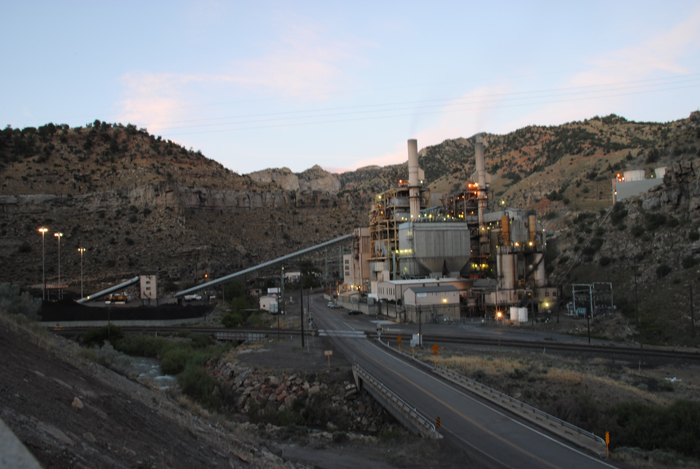
The man bringing business incubation to Carbon County, and jobs that will come with it, sat down with me following a “25k Jobs Launch Tour” led by Utah’s Lieutenant Governor, Spencer Cox, who also spoke with me.
Tami Ursenbach, Carbon County economic development director, said last month at a commission meeting that the old JC Penney in Price, Utah, would be transformed into an “Opportunity Hub.” The facility, essentially a co-working space, is owned by Joel McKay Smith, CEO of Accelerant Business Solutions Provider.
Co-working spaces are designed to allow for entrepreneurs to collaborate as they develop their businesses. The county estimates that Smith’s operations will result in 150 jobs in the first year and grow to thousands of jobs.
The “best-case scenario” for operations is early November; stakeholders may break ground in September, Smith said.
Businesses coming
Smith is bringing in Blacksmith International, a corporation whose work includes cutting and sewing. HealthEquity, a health savings company, will be one of the building’s “anchors,” Smith said. In addition, Opportunity Hub will create an “extension” of a film studio, Studio 11. Four to six work stations are planned that filmmakers can rent out. They could unload their hard drives in Price after coming from the south, rather than driving into Salt Lake City, to do it, Smith noted.
The actual applicant for a grant from the U.S. Economic Development Administration is FutureINDesign, a program that is bridging Utah’s low-income families and the tech community.
“This is as good a turnaround as we’ve seen anywhere,” Cox said at the 25k event. Smith remarked that the Price City Council is committed to help.
“They are going to do everything they can… to help us expedite things so we can get the traffic going,” he said. “It’s going to be an opportunity hub. … but the whole concept is to be able to treat this as the first true model of what we’ve been building out the past few years.”
‘The ‘perfect’ location’
Price is the “perfect” location to launch from, Smith said. “It’s proximity to the Wasatch Front is relatively close,” he added. “You have lots of people who drive over the mountain.”
Smith noted that his team’s work has garnered the attention of Silicon Slopes. Clint Betts, executive director and editor-in-chief of the Silicon Slopes organization and magazine, respectively, attended a press conference to kick off the local 25k. Vale Hale, executive director of the governor’s office of economic development, also attended. Derek Miller, CEO of the World Trade Center Utah, provided opening remarks. With Cox, he is leading the initiative, consisting of visits to 15 rural counties. The Carbon County stop came Aug. 9 at USU Eastern’s Jennifer Leavitt Student Center.
Smith spoke up when asked about bridging economic needs in rural and urban Utah. “I think that I’ve failed if all I do is bring money that’s going back to the Wasatch Front here,” he said. “It has to be a situation where we spawn innovation so companies can be based here, with the community capital staying here. But that’s not immediate. It’s got to be both of those things. You can’t start from scratch and all of a sudden, be thriving. You have to have a collaborative interaction between the urban corps and the rural community,” he added. “It’s not going to work unless you can solve a need for the urban corps.”
For his initiative, Smith targeted 16 counties, not taking into consideration the “shoulder counties” – those that had a metro designation or bordering a major municipal, economic-driver location.
“That all changed,” Smith said, when Utah Gov. Gary Herbert made a challenge in his State of the State address of creating 25,000 jobs in in rural counties in the Beehive State – the “genesis” of the 25k tour, Miller noted.
Smith noted that 20 entities are working on the initiative. “The one underlying fact is there are more jobs on the Wasatch Front that can’t be filled and there are more people here than jobs. The eventual goal would be able to make it where you can reclaim that human resource that are the kids that leave because they can’t find anything here that matches their aspirations. You have to be able to bring them back.”
Smith, Ursenbach, County Commissioner Jake Mellor, Betts and others spoke Tuesday in downtown Salt Lake City in a panel discussion about the employment divide between the Wasatch Front and rural Utah.
Cox on Carbon County
“I think light manufacturing could do well here,” Cox said. He pulled out lively, colorful socks made in Logan in an effort to show that exciting products are being manufactured beyond Utah’s urban regions.
“We have the workforce ready to go,” he said. “They’re hard workers, they’re educated and they can do this stuff.”
Cox and Miller came to USU Eastern’s Jennifer Leavitt Student Center Aug. 9 as part of the duo’s visit to the counties.
Cox described Carbon County as a “poster child” for an “old economy” and what happens when economic change hits a county “hard and fast.” He said that the county would continue to experience an economic downturn as it related to natural gas. He commented that many locals commute to Utah County for work. “That’s not a good way to live your life,” he said.
But he added that he has specifically mentioned the county to manufacturing employers as a “magical place” because of the area’s inexpensive land and power – and the workforce is willing to work hard.
Cox, who noted that he is from rural Sanpete County, lauded the county for its telecommunications infrastructure, pointing out that many jobs for high-tech companies can be filled from home. He opined that the loves the county’s “entrepreneurial spirit.”
“Carbon County isn’t for everybody, but it is for somebody,” he said. “We can do sophisticated stuff here. It’s just a change of mindset and people realizing there’s a great workforce.”

